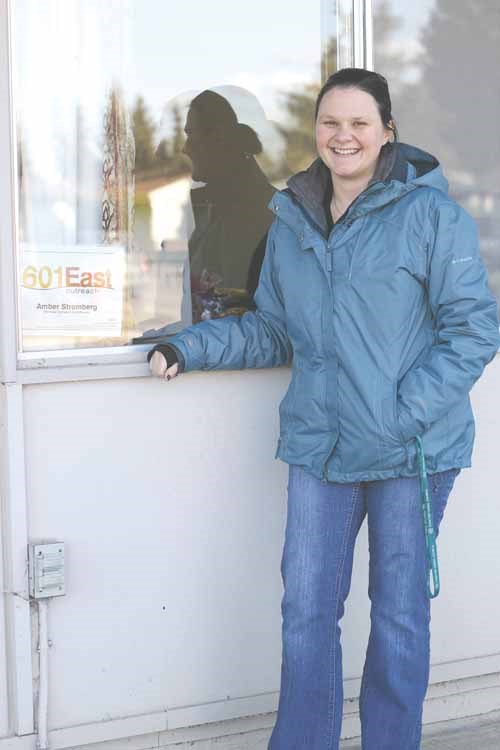It's been called a "crisis."
The rate of new HIV infections in Saskatchewan is now almost three times the national average. For the past several years, the number of people contracting the virus has neared 200-about 40 percent of them women.
Even more troubling is that the incidence rate has reached this level in just a few short years. In 2002, the province had only 26 new cases.
As part of a provincial assessment, Yorkton was chosen last year, along with Swift Current and Prince Albert, as one of the Saskatchewan cities most in need of an HIV outreach program. Through funding provided by AIDS Saskatoon, a satellite branch of that city's 601 Outreach Centre titled the 601 East was opened in Yorkton last October.
Since that time, 601 East coordinator Amber Stromberg has been visiting schools and other sites around the region to give educational presentations. The rest of the time, her door at room 130 in SIGN on Broadway is open for one-on-one meetings with clients in need of assistance or additional information.
"Primarily, my job is prevention through education," says Stromberg.
This winter, the 601 East Outreach program is becoming a full-fledged drop-in centre. Starting on World AIDS Day, Dec. 1, the office will begin offering a host of services previously unavailable.
The outreach centre isn't just for HIV-positive individuals. Stromberg, in fact, has no idea how many of her clients have the virus; she doesn't ask them to disclose. The centre's goal is instead to provide whatever services and information are required by those in need, whether that means helping them manage the disease or helping them avoid behaviors and escape situations that put them at risk of contraction.
Stromberg hopes to make the drop-in centre, above all, "a place where people can feel safe." The office will make available free snacks, condoms, phones, and computers. Staff may assist visitors with writing resumes and finding housing.
The list may not seem to carry much of a common theme, but each service will contribute towards bettering the lives of poor and at-risk populations. Improvements in public health should be just one of the resulting benefits.
"It's important for marginalized people to know that somebody is going to support them and not judge them and just be there for them, and then they can have hope for the future," Stromberg says.
Exactly how large a problem HIV is in the Yorkton area is difficult to know. While infection rates here appear to be lower than in some of the worst-affected areas such as the Saskatoon Health Region, relatively little testing is done. Yorkton was identified as a potential problem area because of a recent spike in other STIs such as syphilis, gonorrhea, and Chlamydia, explains Stromberg.
"What it's telling us is that people aren't practicing safe sex. When you see a spike in STI infections, what usually follows that are new HIV infections."
What is known is that the virus is hitting Aboriginal populations and reserves especially hard. According to the Ministry of Health, 79 percent of new infections in Saskatchewan in 2009 were of Aboriginal residents.
There are obstacles to reducing the infection rate both on reserve and off-and one of the largest among them is public attitudes.
Saskatchewan schools have traditionally favored a conservative, abstinence-only approach to sex education: something which research has repeatedly found to be ineffective.
That approach is beginning to change, but Stromberg's message is still not welcome in all schools.
"I'd like it if I could go and even just talk about tolerance, and about how you don't have to be worried about sitting next to someone with HIV.
"Even to reduce some of the stigma-there is a lot of stigma around people infected with HIV, and that's why in a small community they usually choose not to tell anyone."
The idea that AIDS is a disease of gay men-with all the baggage that comes with it-is another myth that continues to perpetuate.
It's particularly untrue in Saskatchewan, where injection drug use is the top cause of exposure and male-to-male sexual contact was a factor in just 4.5 percent of new infections in 2009 (Public Health Agency of Canada).
In Yorkton, the response has been mixed-and occasionally hostile-to Stromberg's attempts at sharing even the most inoffensive of details on the current HIV crisis. While handing out informational cards, she has had tense interactions with those who prefer to think of AIDS as a "gay plague."
Saskatoon's main 601 Outreach Centre goes much further: distributing condoms in public places, for example.
"Yorkton is not ready for that," says Stromberg, "by any stretch of the imagination."
But the outreach coordinator will continue to attempt smaller steps.
"Once you can dispel any myths or negative thinking about things, people will generally come around."
In Saskatoon, churches have become the outreach centre's biggest supporters. That level of acceptance is a long-term goal for the Yorkton program.
"I hope people will understand that we're just here to help people out," Stromberg says.



